Writing: @Caesar @Holographic Research Team
Layout: @Lexi
After the rise of GameFi, the entertainment nature of games seems to have been diluted. It appears that people are willing to spend time on Web3 games because they can make money, rather than because Web3 games are fun or offer a unique native experience. Indeed, due to technical limitations, the high-frequency interaction and immediacy of games cannot be guaranteed.
However, this does not prevent us from considering what games are more suitable for entering the traditional game paradigm of Web3 at this stage. Trading Card Games (TCG) may be one of them, and the TCG itself can focus on playability, transferring the economic attributes of GameFi to the in-game derivative trading market. The playability and economic attributes of the game can be combined and complement each other.
1. What is TCG
First of all, what is TCG? TCG stands for Trading Card Game. As the name suggests, these games are based on collecting cards. Players need to purchase random booster packs, collect cards, and then use different cards flexibly to build decks that comply with the rules and play the game according to their own strategies.
Since each player's deck is different, and the order of drawing cards in each game is also different, endless variations arise. Players need to constantly use their brains to think during the preparation and gameplay. Generally speaking, these cards have certain value, and players can trade and exchange their cards with each other. 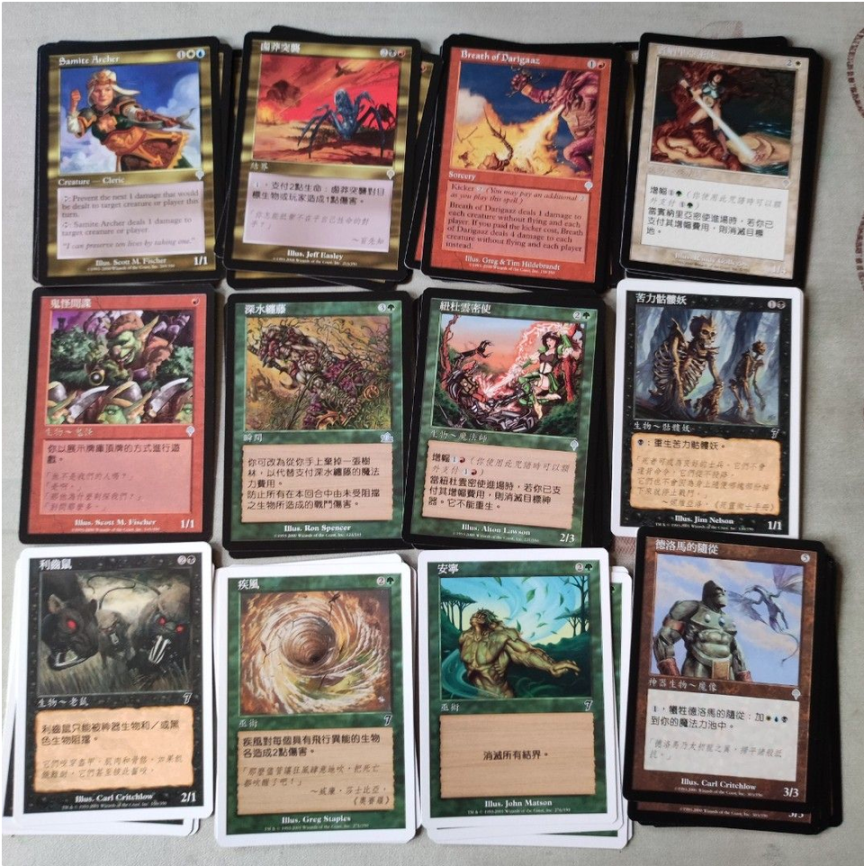
Magic: The Gathering
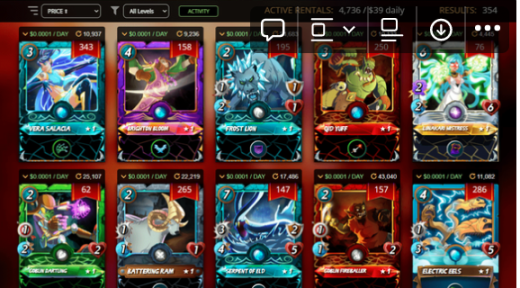
Cards in Splinterlands
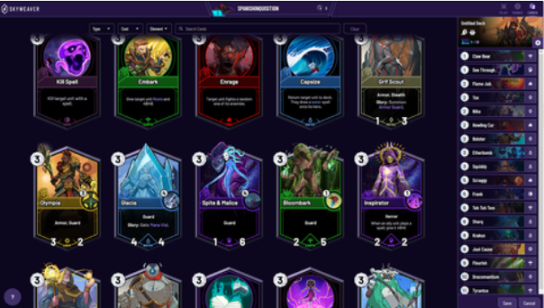
Cards in Skyweaver
1.1 Common Features of TCG
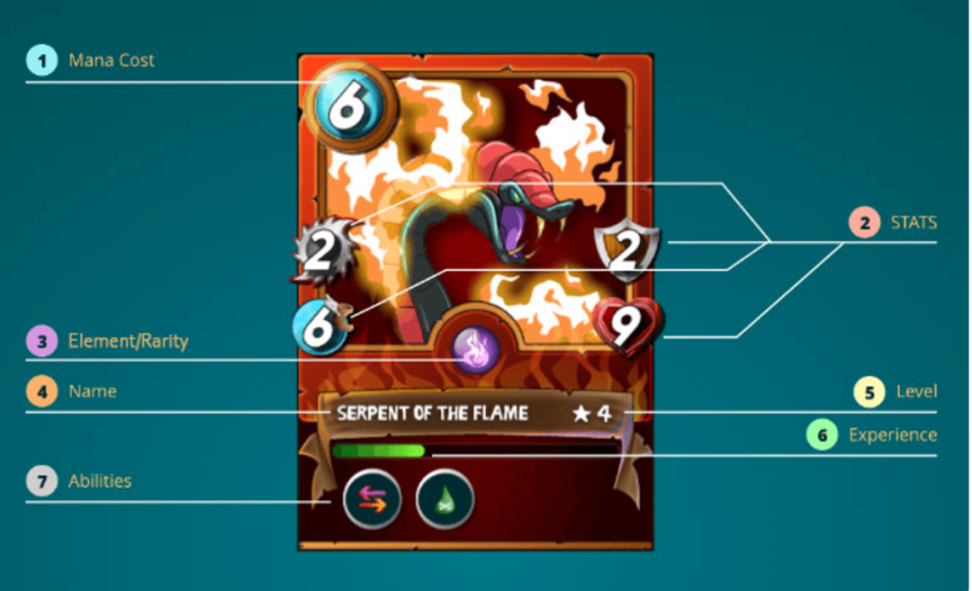
The card in Splinterlands shows the card's name, the mana value required to use the card, the character's power/speed/toughness and life, rarity, card level, card experience, and special abilities.
a. Each card has text describing the rules, including the conditions and effects of using these cards.
b. Players need to have a deck, and they need to select a certain number of cards from thousands of cards to work together to win the game, providing a lot of openness and diversity for the game. To lower the barrier for new players, most TCGs provide pre-built decks, but players need to improve the strength of the deck based on their own understanding to achieve victory.
c. Using any card requires certain conditions, such as the mana value required to use the card in Splinterlands mentioned above.
d. The basic rule of the game is to use one's resources reasonably to produce a certain effect and achieve the winning condition of the game.
e. Regardless of the game and its rules, they are all played in turns, and the turns follow a certain structure.
1.2 Turn Structure
Start/Reset Phase — All cards become the state of a new turn. Most TCGs have similar designs, although some have unique designs.
Draw Phase — Draw cards from the deck to the hand. Drawing new cards may mean new effects.
Use Phase — Use the effects written on the cards to influence the game.
Conflict/Battle Phase — Use available resources to engage in battle. Winning conflicts is generally the main means of winning the game.
End Phase — Generally, at this stage, the effects produced by the cards used in this turn will end, and players will be required to discard any excess cards in their hand to maintain a certain number of cards in hand.
1.3 Issuance and Operation
Players need to purchase cards from the game publisher to play the game. This is mainly done through purchasing "booster packs," which contain a certain number of random cards. Most games have "starter packs," which contain a complete set of basic decks, aimed at helping new players understand the rules.
Cards in the game have different levels of impact, with varying strengths and weaknesses. To prevent the proliferation of powerful cards, most game publishers use rarity to control the proportion of cards of different strengths. A common method is to divide them into "common cards," "uncommon cards," and "rare cards." For example, a booster pack of Magic: The Gathering contains 15 cards, with only one rare card, three uncommon cards, and the rest being common cards.
To give the cards additional value, game publishers will print special cards, with "foil cards" being a more traditional method. These specially printed cards are very exquisite and have strong collectible value.
For example, Yu-Gi-Oh! (a card game based on the anime of the same name) has a large audience worldwide, translated into multiple languages, and has spawned a large card trading and collecting market. Over 22 billion Yu-Gi-Oh! cards are in circulation, with many cards valued at thousands of dollars, and the highest-value collectible cards reaching up to 9 million dollars.
Next, I will use two projects, Splinterlands and Skyweaver, which have different design focuses, to analyze the reasons behind the different development situations of the two projects and discuss the present and future of TCG on the blockchain.
2. Splinterlands and Skyweaver
2.1 Basic Information
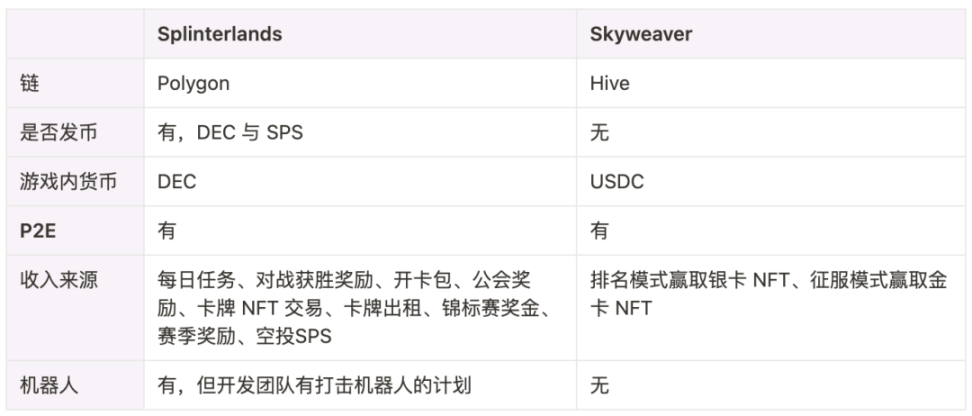
2.2 Development Situation

Due to the lack of data on Skyweaver from various data analysis platforms after 2022, let's look at the closest data point around mid-2022. We can see that the number of users and transactions in Splinterlands far exceeds Skyweaver, and it is in a relatively stable state. Since July 2021, with the popularity of TCG games, Splinterlands has experienced unprecedented growth and gradually entered a stable period, while Skyweaver, after two to three years of testing, has not yet broken through the glacial period.
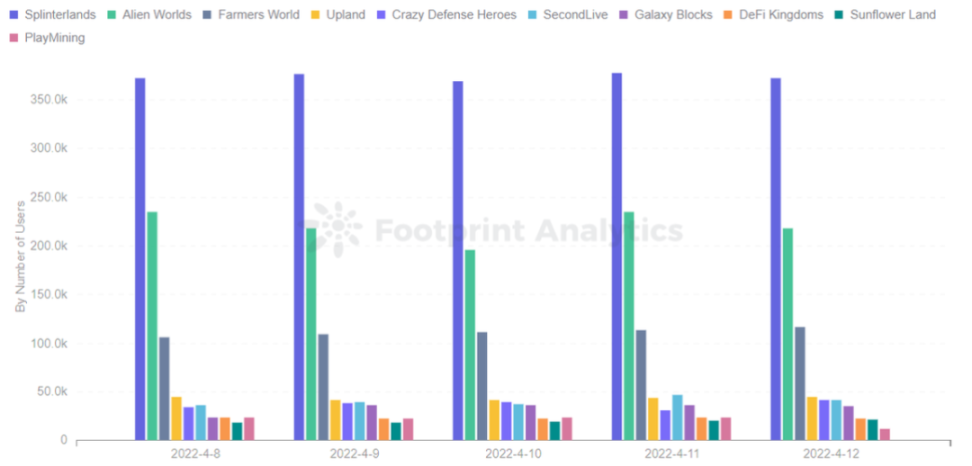
As of April 12, 2022, Splinterlands has ranked first multiple times with over 350,000 daily active users, leaving the second and third places, and even Axie Infinity, far behind. It can be said that it is currently the undisputed king of blockchain games.
In a similar environment, why do two TCGs with similar core gameplay have such a stark difference in development?
2.3 Core Differences Between Splinterlands and Skyweaver
2.3.1 Tokens
After its financing in July 2021, Splinterlands issued its own tokens, establishing a dual-token model with $DEC and $SPS.
$DEC is the in-game currency, currently priced at $0.00076335, mainly used for in-game purchases of various card packs, land, items, and improving personal rankings, which can be obtained through various in-game tasks and official activities, or purchased on trading platforms. $DEC can be traded for cash and used to purchase items, lease cards to improve battle win rates, earn more battle rewards, and trade rare cards in the NFT market.
$SPS is the governance token, currently priced at $0.01717423, mainly used for community governance voting, game rewards, and staking rewards. Holders can stake $SPS for voting and decide on any adjustments to the project, including Splinterlands-sponsored match schedules, settings, and prizes, card supply updates, mission, season, and leaderboard rewards, battle settings (time limits, mana caps, rule sets, non-active shards), and $DEC inflation pool.
Skyweaver, on the other hand, did not issue its own tokens and uses the stablecoin USDC as the in-game currency.
2.3.2 Play-to-Earn
In Splinterlands, players can participate in the game for just $10. Compared to similar games, the Play-to-Earn gameplay has a relatively low threshold, and there are various simple ways to earn income.
Daily tasks: Daily tasks refresh every 24 hours based on the first completion time, and tasks of different levels reward different numbers of chests, which may contain $DEC and cards of various levels.
- Battle Victory Rewards: The winner of each battle will receive a reward in $DEC tokens, which currently have a market price of 0.00076335U. As players level up, the single battle DEC reward also increases.
- Opening Card Packs: Opening card packs is similar to blind boxes, with each pack containing cards of varying value. What can be obtained depends on luck, but historically, the average return value of card packs has been greater than the selling price. There is also a chance to obtain potions from daily tasks, which can increase the probability of obtaining legendary and gold cards when opening card packs.
- Guild Rewards: Participating in a guild can earn exclusive rewards, but guild construction and battles have certain level requirements for members.
- Card Trading: Different cards have different supply and demand, and the trading value of each card varies.
- Card Rental: Cards can be temporarily rented out, and the lessee can use the cards to improve their game win rate.
- Tournament Prizes: The entry fees paid by all participants in tournaments form the prize pool, and different prizes are awarded based on final rankings.
- Season Rewards: Season rewards also increase with different levels. In addition to points, season rewards also take into account the corresponding value of held cards, measured in the game by power. To earn stable season rewards, many people may consider holding high-value cards in hand, similar to the model of staking card NFTs to earn rewards.
- Airdrops: Airdrops are distributed based on a player's game contributions (mainly the weight of in-game assets on the blockchain) and the amount of SPS staked.
The Play-to-Earn gameplay of Skyweaver is different, mainly divided into the free-to-play Ranked mode and the paid Conquest mode. The game's earnings mainly consist of two types of NFTs: gold cards and silver cards.
- Silver Card NFTs: These can be obtained through weekly leaderboard rewards in the Ranked mode (the higher the ranking, the more silver cards won), or by winning matches in the Conquest mode. Silver cards are tradable versions of basic cards and can also be used to pay for entry tickets in the Conquest mode.
- Gold Card NFTs: These are loot version cards created and obtained by winning all three matches in the Conquest mode, with limited supply. There are 8 different gold cards available each week, and once the week ends, these 8 gold cards cannot be won again. After that, they can only be obtained from other players in the store.
2.3.3 Other
Splinterlands
In addition to tokenizing NFTs, Splinterlands has added elements such as land auctions, NFT card trading, and card synthesis to increase the liquidity of cards and land. Players can trade or sell their in-game assets to other players. The greater potential of Splinterlands lies in its land-based metaverse world, supporting players to create guilds, build castles, and create a broader metaverse space. Splinterlands has a clear roadmap, presenting various future plans to players.
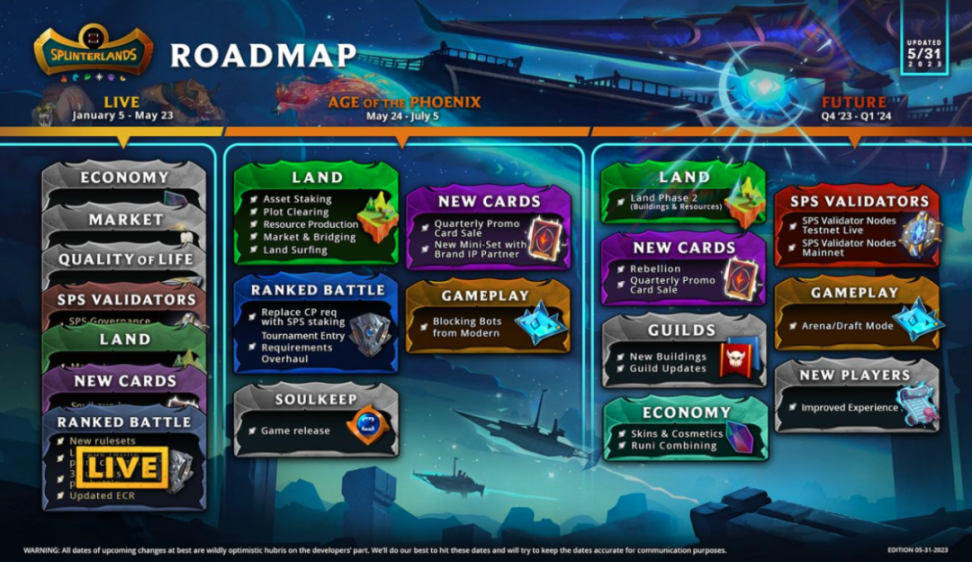
Skyweaver
In contrast to Splinterlands, Skyweaver does not have a particularly clear roadmap, and the game's balance is relatively poor compared to Splinterlands. In mid-2022, the project team Horizon directly stated that the current focus is on helping more games, applications, and brands enter Web3. The team indicated that they would announce more partnerships, from games to map technology, to loyalty reward programs, and to the token experiences being developed by different companies and brands. This may indicate that Horizon will not invest too much effort into Skyweaver in the future, leading to a general loss of confidence among players.
2.4 Reasons for Development Differences
Both games emerged during the GameFi boom, with playability and economic benefits being two ends of the same scale.
Splinterlands offers a more diverse range of earning methods, making it an efficient gold-making model with a certain level of playability, closer to the early GameFi design. The game's dual-token model is more designed to serve economic attributes, and the airdrop of SPS and open governance bring low-cost community marketing and highly sticky early participants, driving Splinterlands' popularity to new heights. Splinterlands' roadmap is not only clear but also presents a land-based metaverse world, closer to the popular narrative at the time, generating higher levels of discussion and participation.
On the other hand, Skyweaver's gameplay is relatively monotonous, and it did not provide any special means to attract users during the cold start phase. The low number of players led to longer matchmaking times, reducing the efficiency of earning, and the NFT card market did not exhibit any bullish behavior. When playability is not enough to cover the inefficient gold-making model, the high learning and time costs of TCG games, combined with market sentiment, can wear down players' patience, while the lack of a clear and imaginative roadmap from the Skyweaver team further fuels negative community sentiment and user attrition.
The reasons behind the development differences between Splinterlands and Skyweaver can be summarized in four aspects:
- Economic Incentives: Value capture and economic subsidies are crucial. In this environment, to attract more traffic and users, economic incentives are necessary, but the trade-off between playability and economic incentives needs to be carefully considered.
- Community Culture and Creator Economy: Player feedback on the game, internal community culture, and user-generated content are important for game operation and development. Early high-engagement participants have a profound impact on the project.
- Operational Issues: A clear roadmap and a long-term community atmosphere can lead to higher user retention and activity, reducing user attrition. Even if it does not align with current hot topics, at least a clear, reasonable, planned, and step-by-step implementation is needed.
- Industrialization of Games: Whether the learning and time costs of the game are reasonably estimated and measured, and how to balance rewards and costs, requires systematic and experienced game planning.
3. Propositions to Consider in Web3 TCG Game Design
3.1 How to Regulate the Economic Sustainability of NFTs Rationally?
The mindset of most game NFT holders in Web3 games is similar to that of NFT investors, hoping for the scarcity of game NFTs to maintain or increase their value. Game NFTs can serve as rewards for scarcity, acting as a value carrier and investment tool in the market. However, this needs to be based on the richness of game development and the fun of the game. The contradiction between these two aspects may lead to community and developer opposition, causing governance issues. If the community can adopt a long-term and rich mindset, continuously building the ecosystem will bring about a virtuous value cycle.
For example, LOOP's development of derivative products and related protocols initially led to a halving of the price of LOOP NFTs, but later captured far more value than expected. Before independent development within the community, game developers can control the inflation rate of NFTs through appropriate mechanisms to ensure a balance and consistency of interests between early and later participants, and adjust their development roadmap.
Currently, the season or limited-time game cycle is a relatively feasible sustainability mechanism. Dark Forest and Dookey Dash also control the scale of reward acquisition through limited-time openings, i.e., the inflation rate of NFTs. This mechanism is reflected in Web2 as well, through seasonal iterations based on different gameplay and deck strengths, combined with worldviews and background stories to achieve seasonal iterations. For new players, they can participate in the game with a reasonable learning cost, while for old players, they are compensated for the new season to retain them. The coordination of interests between early and new participants is essential for further growth.
Another proven healthy economic design is to control the supply through the release and burning of tokens and NFTs. The season reward mechanism provided by Splinterlands and the mechanism of burning silver cards for Conquest mode passes in Skyweaver have brought about reasonable economic cycles on a small scale.
3.2 How to Balance the Two Ends of Play-to-Earn?
Web3 games initially attracted a lot of market attention and user adoption through GameFi and Play-to-Earn, but many GameFi gameplay methods are not fundamentally different from DeFi mining, where NFTs are purchased as production tools for continuous earning. In other words, most early GameFi was more of a fun money-making mechanism centered around Fi, rather than a game-centric game. However, there has not yet been a gameplay core in Web3 games that can achieve mass adoption based on the unique Web3 experience. If judged solely based on traditional "fun" games, many games' gameplay and development require a long period of maturation.
In terms of playability, TCGs offer both vertical and horizontal expansion methods. For example, Hearthstone brings vertical card mechanism design through seasonal iterations and different races and their characteristics, while the expansion of gameplay brings horizontal ladder, arena, and chess gameplay, providing different but rich playability experiences for different types of players.
From the perspective of Fi, as users have become accustomed to the plate-style capital pools provided by early GameFi, they have learned to efficiently earn high returns through super simple gameplay. TCG games, with their high learning costs, need to consider how to balance gameplay difficulty and earnings:
In terms of play difficulty, more consideration needs to be given to learning costs, matchmaking times, and the cost of building decks;
If the Earn reward is NFT cards, the value needs to be viewed in two parts: the utility value of building cards and the collectible value depending on rarity. However, in the current NFT market, it is difficult to define the collectible value, greatly reducing the desire to collect. As for the utility value, game developers need to balance the cost of acquisition and game balance.
If the Earn reward is the game's native token, developers need to design the token's economic model, value capture, and utility. Currently, GameFi offers a multi-token model as a solution.
Looking at the success of Splinterlands, Fi can be considered from two aspects: opening card packs (primary market) and card rental and trading (secondary market). Game NFTs are more determined by utility and community culture, with the former being more decisive and linked to the playability of the game. The act of opening card packs can be seen as obtaining basic game tools, such as opening card packs and providing potion items in Splinterlands. This randomness can increase the perceived value of rare cards opened from card packs. The gameplay of renting and trading is diverse, but fundamentally, cards are seen as the basic production tools for economic rewards.
Certainly, in the comparison between Splinterlands and Skyweaver, we can see that in the current Web3 game ecosystem, diverse earning pathways and strong Fi attributes are still an indispensable part of engaging players and revitalizing the game ecosystem.
3.3 How to Balance Free Players and Paid Players?
For games, in the Web3 world where traffic is scarce, free players need to be considered as they can bring activity to the early game ecosystem. This requires game developers to pay attention to two points:
- Cultural considerations for the game should avoid being too niche. While this is beneficial for attracting long-term and sticky users with similar interests, quickly building a community and giving it cultural attributes and strong social relationships, it is not conducive to triggering a tipping point, attracting a lot of market attention, and compressing the game's subsequent expansion and operational margin for error.
- Game projects need to be cautious about token issuance. Some projects, without the ability to run a Ponzi scheme, use token issuance as a marketing tool, leading to a collapse and causing the game to fall into trouble prematurely.
In terms of game attributes, TCG is relatively friendly in terms of "whale spending." More than money, the cost is more in terms of time. It takes time to unlock free basic cards, and time to learn and think about how to build a strong deck to win more rewards. As users participate for longer periods, through the exchange and trading of card NFTs, the deck gradually forms a "perpetual motion machine," allowing players to play with a P2E deck in each season. At the same time, during this process, players' understanding of the game continues to improve, increasing the likelihood of earning higher rewards. In other words, it is possible to effectively use potential, continuous, and long-term rewards to motivate players to invest more time and possibly even convert free users into light-paying users.
Of course, as mentioned earlier, many players still have a strong speculative nature. Some players do not join the game but hold NFT cards as investments or for speculation. Some players attempt to monopolize the trading of a specific NFT card to earn higher returns. The speculative atmosphere of meme coins during the hype period often spills over into the game community, where everyone seems to be more interested in making quick money. Therefore, for the Web3 game ecosystem, users are a double-edged sword, depending on the mechanism design of developers and the culture and atmosphere of the community.
3.4 Do We Need a Full-Chain TCG?
GameFi's TCG, whether through purchasing game NFTs or earning card NFTs through P2E mechanisms, is similar to the behavior of buying card packs and extracting cards in TCG. The trading of game NFTs is also similar to the TCG card trading market in Web2, including the levels of so-called common, uncommon, rare, and foil cards, which align well with the rarity mechanism of the NFT market.
Taking the example of the well-established trading card game Yu-Gi-Oh!, there are currently over 22 billion cards in circulation, with many cards valued at thousands of dollars. The most valuable cards are even worth up to 9 million dollars (the reason for such a high price is because it was the prize for the champion of the first Yu-Gi-Oh! tournament. Here, it is worth mentioning the potential of Web3's ability to trace ownership history, which could bring huge potential to the card collecting market). The more open and transparent NFT market of Web3, along with the collection of secondary transaction fees, provides the TCG card market with greater space for design, nesting, and development.
GameFi + TCG allows developers to give games "Fi" without deviating from the core of "Game." This can be considered as a solution before fully understanding the native experience and operation of Web3 games. Although the market's criticism and reflection on GameFi are increasing, I still believe that games like TCG are more suitable for being a type of GameFi game.
Recently, there has been increasing discussion about full-chain games, and many opinions seem to believe that a full-chain game is the only solution for blockchain games. In August, Norswap tweeted that 0xFable wants to create a highly scalable full-chain TCG, and Paradigm and Base are supporting the development of Parallel, a card game set in a blockchain world, which has started public testing and operation. However, a question worth discussing is whether we really need a full-chain TCG?
First, from the perspective of full-chain games, the "impossible triangle" of decentralization, security, and scalability inevitably needs to be considered. Limited by the performance and storage limitations of the blockchain, the high-frequency interaction of games, i.e., immediacy, will be significantly affected. However, with the optimization of tick rates by full-chain game engines, the development of technologies such as Ephemeral Chain, app-specific precompiles, Battle Rollup, and synchronization mechanisms, it will be possible to achieve high-frequency interaction for players, pushing the user experience of blockchain games to new heights. Whether it's traditional MMORPGs, SLGs, or more open and customizable rule-based open sandbox worlds, they are all worth looking forward to. I am optimistic about the future development of full-chain games.
However, if performance issues are resolved, many more playable game mechanics can be moved onto the chain. Taking Dark Forest as an example, all interactions are completed on the chain, and zero-knowledge proof (ZKP) technology can help Dark Forest achieve higher levels of information warfare, improving the playability of the game and making up for its shortcomings in high-frequency interaction.
If performance issues are resolved and the game experience is optimized, the highly unique Web3 experience is bound to attract a large number of participants and enthusiasts. However, TCG is ultimately a niche game, and in the Web2 world, it does not necessarily have the best playable gameplay experience. For such games to compete with other gameplay, seeking a place for TCG in the already small volume of Web3 itself is a long and arduous journey. It is difficult to see the significance of moving an entire game to the chain, especially since TCG games require a lot of interaction, which undoubtedly increases the cost for players, and this is difficult to compensate for with playability.
Of course, in the game race, there are other influencing factors, such as marketing, world-building design, and the coordination of user-generated content. In the Web3 world, where community culture is particularly important, some full-chain TCG games may experience a temporary surge in popularity, but with a fixed game mode, the overall process cannot be adjusted too much after the game is launched, as it would increase the learning cost for players and lead to user attrition. If a full-chain TCG is to be developed, it cannot only be a TCG, but needs to be a game matrix similar to Splinterlands with land and an open world, or a game with a unified worldview like Parallel.
Apart from GameFi and full-chain games, are there other possibilities for TCG? Yes. Design the core gameplay of the game and put it on the chain, while leaving the rest of the imagination space for ecosystem participants to freely develop. Similar to playing cards, only design aspects such as suits, ranks, and materials, while specific gameplay is developed and designed by players themselves. Taking Magic: The Gathering as an example, because the rules did not prohibit it, there were cases of players tearing up cards at early tournament venues to maximize the card's effect (using the physical properties of the card), known as the famous Chaos Orb incident. This action led to the addition of a rule that "cards must be intact" in the game thereafter. Players have unlimited imagination, and the combination of user-generated content and creator economy gives full freedom and design space to TCGs on the chain. Within the same card system, we can have countless rooms and countless gameplay possibilities. In my ideal trend of Web3 game development, in addition to ownership of game assets, it should also bring about the unity of player and creator identities, and the co-construction, prosperity, and common prosperity of the game.
To conclude, quoting the views of Daniel Alegre, the new CEO of Yuga Labs, he believes that the advantage of Web3 lies in achieving low marketing costs through close community word-of-mouth and giving players real ownership. In his view, the experience of the game and the application of Web3 have strong similarities—placing creators and the community in the most important position, creating a strong connection between content, entertainment, and users.
4. Conclusion
When Web3 is combined with games, I find it difficult to find a suitable perspective for observation and contemplation. Naturally, we bring in various roles, such as investors, players, creators, developers… But setting aside these identities, we must remember that the core priority of games is entertainment.
The GameFi frenzy was not only driven by game creators but also by game participants. In reviewing and reflecting on GameFi, we must also consider that initially, we hoped that Web3 would bring us ownership of game assets, a better virtual experience, and unprecedented gaming experiences. However, gradually, obtaining assets in Web3 game projects became the sole purpose for many users to participate in the game.
As a player, I don't just want to see walking, sleeping, and raising virtual pets as ways to make money. I want to see a game that resonates with me, one that values the visual quality of the game's graphics, has a rich storyline, and allows me to fully immerse myself in every battle, every story, and every world. Only then can we have a vibrant and creative encrypted game ecosystem that can attract players in the long term.
免责声明:本文章仅代表作者个人观点,不代表本平台的立场和观点。本文章仅供信息分享,不构成对任何人的任何投资建议。用户与作者之间的任何争议,与本平台无关。如网页中刊载的文章或图片涉及侵权,请提供相关的权利证明和身份证明发送邮件到support@aicoin.com,本平台相关工作人员将会进行核查。




